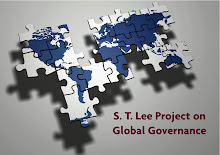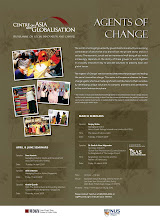 Tikki Pang, a member of the S.T. Lee Project's Global Health Governance study group and Director, Research Policy & Cooperation at the World Health Organisation (WHO), emailed in few days ago a thought-provoking piece written by David Brooks of The New York Times. The Brooks' article addresses global health governance in the current context of the potential swine flue epidemic and the relative merits of a "top-down" centralised response versus a much more "bottom-up", decentralised approach in the context of responding to transnational threats like pandemic.
Tikki Pang, a member of the S.T. Lee Project's Global Health Governance study group and Director, Research Policy & Cooperation at the World Health Organisation (WHO), emailed in few days ago a thought-provoking piece written by David Brooks of The New York Times. The Brooks' article addresses global health governance in the current context of the potential swine flue epidemic and the relative merits of a "top-down" centralised response versus a much more "bottom-up", decentralised approach in the context of responding to transnational threats like pandemic.
Swine flu isn’t only a health emergency. It’s a test for how we’re going to organize the 21st century.In these post-cold war days, we don’t face a single concentrated threat. We face a series of decentralized, transnational threats: jihadi terrorism, a global financial crisis, global warming, energy scarcity, nuclear proliferation and, as we’re reminded today, possible health pandemics like swine flu.
These decentralized threats grow out of the widening spread and quickening pace of globalization and are magnified by it. Instant global communication and rapid international travel can sometimes lead to universal, systemic shocks. A bank meltdown or a virus will not stay isolated. They have the potential to hit nearly everywhere at once. They can wreck the key nodes of complex international systems.
So how do we deal with these situations? Do we build centralized global institutions that are strong enough to respond to transnational threats? Or do we rely on diverse and decentralized communities and nation-states?
A couple of years ago, G. John Ikenberry of Princeton wrote a superb paper making the case for the centralized response. He argued that America should help build a series of multinational institutions to address global problems. The great powers should construct an “infrastructure of international cooperation ... creating shared capacities to respond to a wide variety of contingencies.”
If you apply that logic to the swine flu, you could say that the world should beef up the World Health Organization to give it the power to analyze the spread of the disease, decide when and where quarantines are necessary and organize a single global response.
If we had a body like that, we wouldn’t be seeing the sort of frictions that are emerging from today’s decentralized approach. Europe has offended the U.S. by warning its citizens not to travel across the Atlantic. Ukraine is restricting pork imports. Europe could hoard flu vaccines, leaving the U.S., which has only one manufacturing plant, high and dry. Fear of a pandemic could lead to a restrictionist race, as nations compete to curtail movement and build walls.
Those dangers are all real. Yet, so far, that’s not the lesson of this crisis. The response to swine flu suggests that a decentralized approach is best. This crisis is only days old, yet we’ve already seen a bottom-up, highly aggressive response.
In the first place, the decentralized approach is much faster. Mexico responded unilaterally and aggressively to close schools and cancel events. The U.S. has responded with astonishing speed, considering there are still few illnesses and just one hospitalization.
The Times published a photo on Monday of the New York City health commissioner, Dr. Thomas R. Frieden, leading a crisis response meeting. The photo is the very image of a focused, local response. People are wearing polo shirts and casual wear — intensely concentrating on the concrete incidents in their own backyard.
If the response were coordinated by a global agency, those local officials would not be so empowered. Power would be wielded by officials from nations that are far away and emotionally aloof from ground zero. The institution would have to poll its members, negotiate internal differences and proceed, as all multinationals do, at the pace of the most recalcitrant stragglers.
Second, the decentralized approach is more credible. It is a fact of human nature that in times of crisis, people like to feel protected by one of their own. They will only trust people who share their historical experience, who understand their cultural assumptions about disease and the threat of outsiders and who have the legitimacy to make brutal choices. If some authority is going to restrict freedom, it should be somebody elected by the people, not a stranger.
Finally, the decentralized approach has coped reasonably well with uncertainty. It is clear from the response, so far, that there is an informal network of scientists who have met over the years and come to certain shared understandings about things like quarantining and rates of infection. It is also clear that there is a ton they don’t understand.
A single global response would produce a uniform approach. A decentralized response fosters experimentation.
The bottom line is that the swine flu crisis is two emergent problems piled on top of one another. At bottom, there is the dynamic network of the outbreak. It is fueled by complex feedback loops consisting of the virus itself, human mobility to spread it and environmental factors to make it potent. On top, there is the psychology of fear caused by the disease. It emerges from rumors, news reports, Tweets and expert warnings.
The correct response to these dynamic, decentralized, emergent problems is to create dynamic, decentralized, emergent authorities: chains of local officials, state agencies, national governments and international bodies that are as flexible as the problem itself.
Swine flu isn’t only a health emergency. It’s a test for how we’re going to organize the 21st century. Subsidiarity works best.
This article "Globalism Goes Viral" by David Brooks was published in The New York Times on 28 April 2009.












